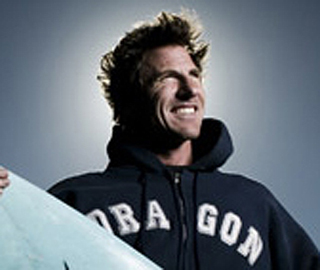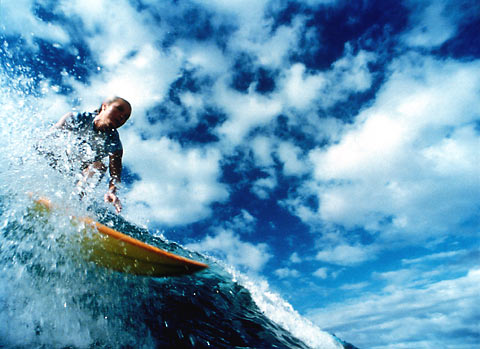
Read more at http://www.surfermag.com/features/john-philbin-08-07/#pKrC5QKKG26FiOqr.99

Read more at http://www.surfermag.com/features/john-philbin-08-07/#pKrC5QKKG26FiOqr.99

LA WEEKLY
ON ANY GIVEN WORKDAY, John Philbin might encounter tsunami waves, dolphins, sea lions or beautiful Hollywood actresses. His office attire consists of “4/3 wetsuit, booties, hood and gloves, sometimes goggles and a hat in the summer.” That is, when he’s not wearing retro-cool sunglasses to production meetings with the likes of Quicksilver Entertainment. Does it need to be said that he’s no relation to Regis?
When asked if he thinks he’s the luckiest person in the world — being the world’s most successful actor/producer/surf instructor to the stars — he laughs. “Very often I do feel that way. Till I see a beginner pushing into their first wave — then I realize my clients are the luckiest people in the world.”
Philbin’s surf-school clients have included A-listers like Kate Bosworth. He’s done more than his fair share in front of the camera, too — having had roles in North Shore, Point Break and Blue Crush. For now, though, he is concentrating on a forthcoming surf documentary and his passion — the school he founded and runs — Pro Surf Instruction (www.prosurfinstruction.com). “I love seeing some little, nerdy kid get his first good, long ride — feel the stoke usually reserved for only the coolest kids on the planet.”
Well suited to his golden-boy niche, Philbin was born in Carmel and raised in Palos Verdes, where his father taught him a love of the ocean. Philbin has particular empathy for both actors and beginning surfers. “When learning to surf, you feel like you’re performing — being watched and judged. You can be too self-conscious. It’s the same in acting. The worst quality in an actor — or a surfer — is being overly concerned with someone else’s judgment of your performance. That said, surfing and acting are both adrenaline rushes. Both can be performances on an elevated plane.”
Surfing, Philbin says, “is an art, like good acting. But unlike acting, you have to respond to the reality around you. The ocean is in charge. And that’s fun.”

A week after turning 37 years old, I was standing on a surfboard riding my first wave following only an hour of tutelage from surfing instructor John Philbin. Its no wonder he also easily taught actress and novice surfer Kate Bosworth how to confidently skim along the water for her part as a professional surfer in the new teen movie, “Blue Crush.”
With his guidance, I had quickly conquered my fears and felt safe on the surfboard. Judging by the ease with which Bosworth paddled into the overwhelming and sometimes deadly waves of Oahu’s North Shore presented in the film, he apparently created the same confidence in her.
Philbin says that this feeling of safety and comfort is his goal with all his students, who range in age from 6 to 65 years old. “My father taught me to enjoy waves in the ocean; he lifted me over them and helped me learn to body surf them,” says Philbin, who has lived in the Palisades since 1989, but grew up in Palos Verdes. “He made me feel safe in the ocean. That’s a gift he gave to me. … Three years ago, I realized I could give that gift to other people.
John and Laurel
Philbin instructs Busby on the best way to protect her head.
Photos: René WileyThat’s one thing people come to me for. A lot of people have had bad ocean experiences or have a bad view of surfers. I find I enjoy teaching people how to feel safe and exhilarated. Everything came full circle.”
The sense of safety Philbin provides does not stem from discounting the dangers of surfing. The warm, affable man gave me a long lecture about safety issues—particularly how I must protect my head as though the surfboard was designed to come smashing into it whenever the board wasn’t under my direct control.
He also told me other surfers will run over me if I am in their way and may purposefully try to hit me. Surfing etiquette dictates that surfers get out of the way of any oncoming surfers. However, Philbin, who has been surfing for 30 years, helped provide a sense of safety by his guidance and presence and by his clear description of the dangers and how to avoid them.
The steady waves of Malibu’s Third Point, near Malibu Lagoon, did not look threatening, and he told me it was one of the safest places to learn in the world. He pointed out the varied aspects of the water, such as the channel, where water is moving out to sea, and the places the waves broke over rocks beneath the water.
When I fell, I learned to wrap my arms around my head when I was both under water and above the water. Interestingly enough, none of the “Blue Crush” surfers do this in the movie, but the technique might have alleviated the main character’s recurring nightmares about bashing her head.
The surfers around us in Malibu also didn’t seem concerned with head protection, even though 85 percent of surfing injuries are caused by head trauma. Philbin says simply by protecting your head, you have eliminated that danger. I also learned never to jump or dive off my surfboard when I needed to get off. To do so could mean snapping my neck by hitting the ocean bottom or lodging my foot somewhere in an unseen hole beneath the shallow waves and breaking a leg. Instead, my whole body should hit the water flat.
I noticed that the “Blue Crush” surfers followed this rule whenever they voluntarily left their boards. I also felt protected simply because he was in the water with me, perhaps protecting me from those bad-egg surfers I had heard about, but also telling me when to paddle and urging me to stand when I simply wanted to lie on the board and glide in like I had done on my first ride.
But once I stood in a low stance, I realized he was right—our bodies feel most comfortable and confident when upright. I rode to the beach with a rush of joy at my success, and he no longer had to urge me to stand. Philbin had also provided me an easy method for propelling myself to my feet, since I couldn’t simply jump into a surfing stance like he does.
We first practiced on the shore, where I did a push up, brought one leg forward, then stood with my feet widely spaced and perpendicular to the board’s length, while my chest faced forward. That was easier to do on land than with a moving surfboard, but knowing the technique made the motion possible for me.
He said my success standing and riding a couple waves to the beach was rare for a first lesson. However, in “Blue Crush,” the 30-year surfer John Philbin walks away from the Malibu waves after a lesson.surfer girls also taught four guys to stand and easily ride the waves in one lesson, but maybe that was just movie magic.
Of course, I didn’t face the challenges actress Bosworth did riding waves for “Blue Crush.” Her character, Anne Marie, had to surf Hawaiian waves more than twice her height. Philbin taught Bosworth for three weeks in the milder Malibu waters, and then two other legendary surfers, Brian Keaulana and Brock Little, took over when she went to Hawaii.
When Philbin visited the set two months later, he was amazed to see Bosworth paddling into Oahu’s 10-foot Pipeline, a North Shore surfing locale he says kills some of the world’s best surfers each year. “To see an actor, a young, female actor, get on a surfboard and paddle it into that part of the world with waves that could kill her—I couldn’t believe they let her do it. … I was proud of her and I was proud of the movie.”
Of course, Bosworth couldn’t do all her own surfing. The physical demands of surfing and wiping out during the long 12-hour film days would have been prohibitive for anyone, Philbin says. “Nobody can do all their own surfing.” Bosworth had a body double, professional male surfer Noah Johnson, who shaved his body and wore a blonde wig and a woman’s Speedo.
Coincidentally, Philbin had also once instructed Johnson, even if only as a joke, for a sports cable show on Fox. Philbin gave Johnson an on-air beginning surfing class and was supposed to be surprised at how fast Johnson caught on. “People who don’t surf don’t get it, but for me it’s really funny to give Noah a surf lesson at Malibu.”
Philbin’s connection to films does not only stem from surfing. In fact, Philbin once gave up surfing to become an actor, a profession which is still a prominent aspect of his life. He has appeared in 30 films and television movies, including the surfing films, “The North Shore” and “Point Break.”
While he now easily combines his two professions, when he was a college student at UC Santa Barbara competing on the school’s surf team, he chose to leave the sport and transferred to USC to devote himself to acting. He earned a BFA in theater, lived in Hollywood and stopped surfing for six years. During that time he earned a part in “The North Shore,” and the surfing movie brought him back to his love of the sport.
Some of his childhood surfing idols, including Gerry Lopez and Laird Hamilton, were in the film. Lopez told him, “Don’t quit surfing again. It’s one of the cheapest, best forms of entertainment and you can do it all around the world for the rest of your life.” Philbin took his advice and has been surfing ever since.
Each year, he not only surfs in California, but also journeys to Java, Indonesia for G-land—a camp where he says the world’s best surfers gather annually to enjoy the world’s best waves.
Along his journey, he has learned humility towards the ocean while also gaining a profound respect and gratitude for its power, which is perhaps the most important thing he tries to share with his students. “Surfers have all been worked and drilled in the ocean and it’s a humbling experience,” Philbin says. “But also, it is a real gift and a privilege to be able to go in the ocean and ride waves—something few people on the planet have the opportunity to do. … Waves are nature’s ways of transmitting energy. There are sound and light waves, but ocean waves are the only waves that humans can interact with in a playful way. I try to teach respect and humility for that privilege. Gratitude.” He adds, “Once you start interacting with waves at that level, you start thinking of them throughout the day.”
I agree with him. Since the moment my surf lesson ended, I have been reliving my exhilaration on the water and looking forward to the moment I can experience it again.
Philbin says, “It can be an addiction. A lot of surfers become adrenaline junkies.” But he also likens surfing to more cerebral physical pursuits. “Nobody will ever master surfing. It’s a practice like yoga. At every level you’re at, if you bring humility to it, you can have as much fun your first day as your last day.”
